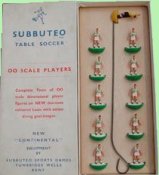
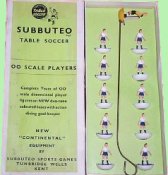
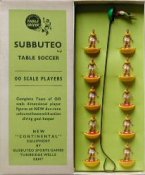
| Peter Upton's |
Subbuteo Tribute Website. |
|
The Team Colours Project. |
|
The Original Heavyweight 1962-68. |
|
Refs 1-54 and 1966 World Cup. |
Clearly one of the key developments in Subbuteo history (and for table soccer in general) was the introduction of 3-D OO scale footballers in place of the flat card (or celluloid) figures. These new figures first arrived in the 1961-62 catalogue. I believe the sets were rushed out for Christmas 1961, with the individual teams arriving a few months later. These new figures were more realistic and more colourful than the earlier figures, and were clearly more attractive to the youth market. In addition, unlike the celluloid flat sides, these teams were sold complete in attractive and practical boxes. Another boon for Subbuteo Sports Games was the 1966 World Cup. Footy fever swept the country and Subbuteo's legendary status was assured.
Mind you, this change in player type wasn't without its detractors. The new figures did not have the delicate balance (and therefore touch and control) of the flat teams. Although the bigger bases pack a decent shot and are better at traveling in straight lines, overall the player is not as good. This meant that the old timers and more serious adult players stuck to the original flat game, while the new OO version was adopted by kids everywhere.
This first heavyweight casting is not a particularly attractive one, although it has some period charm. The player is wearing a short sleeved shirt with a v-neck, both of which are usually highlighted in the painting (although not always). There isn't a lot of detail, and the pose is still a bit flat when viewed from the side. The player's arms are rather thin, and the left hand is often missing. Although all this was probably due to casting limitations at the time.
This first short sleeved design was replaced in the team sets around 1967, when the legendary classic heavyweight first appears. This new long sleeved design was finely detailed, and altogether a more robust figure. If you compare the earlier sets of Airfix soldiers to the later ones, you find the same improvements. Plastics technology was advancing, and so was Subbuteo.......
Box Types.
 |
 |
 |
| Box 1. | Box 2. | Box 3. |
Box 1: White Box - This is the original box, and only had
a very short period of production. A number of Subbuteo histories have dated this
to 1959, but that makes no sense if the arrival of OO scale teams is 1962.
Box 2: - The first green box (although the green is restricted to a panel
on the lid and the insert). This box shows the new improved logo, but the layout
of the writing remains the same as the previous box. The white, printed top layer
is stuck onto a thick rough card box, which is lacking in flaps. The white layer
(plus corner strengthening tape) holds the box together.
Box 3: - The layout of the box top was redesigned, and the box was printed
onto a better quality card. The lids have flaps that are stapled. The staples can
be horizontal or vertical, and there can be two or four staples to each end. There
are also variations in the green colour of the box. This box lasted into the classic
h/w era, and the final versions of this box have folded ends, and no staples.
The Team Colours.
For this page, the team names up until reference 40 come from the 1963-64 catalogue. After reference 40, I've quoted the year of introduction and the name of the original team (as I've done with the flat team page). With the new improved heavyweight arriving in 1967, it was thought that the teams of that vintage (i.e. refs 51 and 52) were the last ones to be produced in the short-sleeved figure. However, a reference 54 Plymouth from 1968 recently passed through ebay, and seemed to be a genuine side. So at present, this is the limit of this list. A Subbuteo dealer has also mentioned having a white 54 Plymouth in this figure that he thought looked okay, but further proof is awaited. The white version comes from 1970, which would seem much too late a date, but this outfit does exist as a celluloid figure (and Plymouth wore it in the mid-1960s), so maybe it is earlier than the catalogues suggest.
Of course, Subbuteo production is haphazard, and a batch of the old figure could've been found and used up later than the rest. Then again, a white 54 would be easy enough to paint onto a plain reference 21.
February 2023: Whilst I am aware of making things too complicated, I can't say no to more photos. So included are extra variations mainly to do with socks. Peter Adolph did not have to worry about socks in the previous card/celluloid range, where they were always printed in black. As sock details were not printed in the catalogue, it seems that these could vary. Sometimes sock variations are all that differentiates 1950s league teams from each other. In general, I think there might be a simple reason. A lot of teams in the 1950s wore hoop socks. A lot of the early "white box" teams seem to have been done in this style, and it looks really pretty. However, it must have been time consuming, and difficult to do well. It makes sense to drop it.
Another oddity which isn't really shown here is the strange early use of flesh plastic teams. In later years, these were only used for teams with no (or very little) white in the kit. However, I've certainly seen refs 1 and 2 painted onto flesh in early sets. I've also seen ref 20, and really oddly ref 10 (with hoop socks). It didn't look like a repaint anyway...





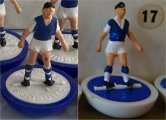
 Sock variations, and the alternate
ref 18 with long sleeves.
Sock variations, and the alternate
ref 18 with long sleeves.



 Original
black shorts version of ref 40.
Original
black shorts version of ref 40.


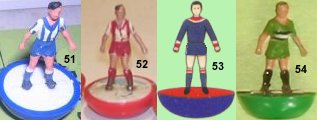

*I remain a little sceptical as to whether teams 53 and 54 were ever produced in this figure. Team 55 Anderlecht was introduced the same year (1968), as ref.53 and the original green ref.54, and a 1969 white Plymouth might bring even more teams into play. Nevertheless, there are a few in collecting circles, and the white team shown did not look an obvious repaint when I held it in my hand... The Historical kits website suggests that Plymouth wore the white version of this kit in 1964-66, then the green version 1966-68, then back to white for 1968-71. Does this give the white kit a short-sleeved window of opportunity, or is this wishful thinking?
World Cup 1966 sides.
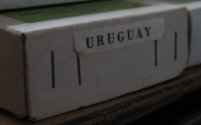
As explained in the World Cup appendix these teams were produced in named boxes for the World Cup. This proved a good marketing move for Subbuteo, as the whole country was caught in the grip of the competition. (well, I say the whole country. I daresay my Dad couldn't have cared less!!)


International Appendices: France, Italy, Germany, Belgium/Holland, Spain/Portugal, Scandinavia, Rest of Europe, and America and South Africa.
Appendices: Team boxes, World Cup 1966, Super teams, The Italian Production Appendix
[ Main Page | Previous Page | Next Page ]